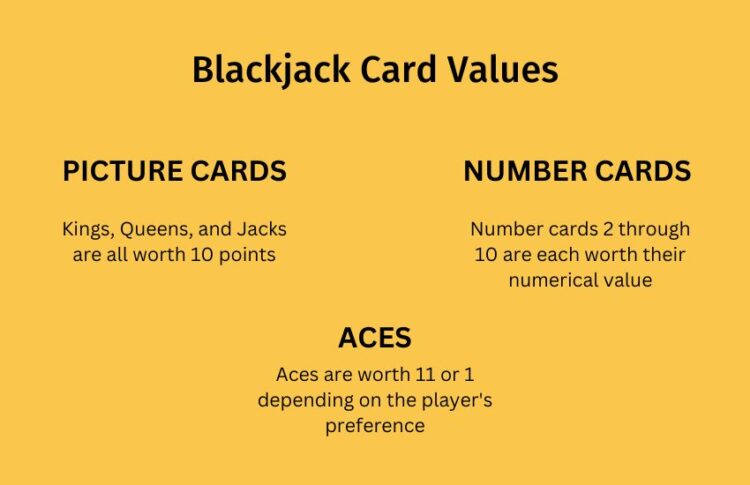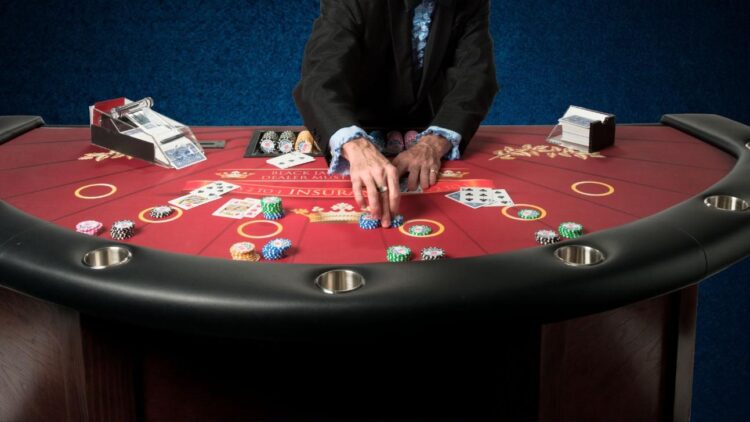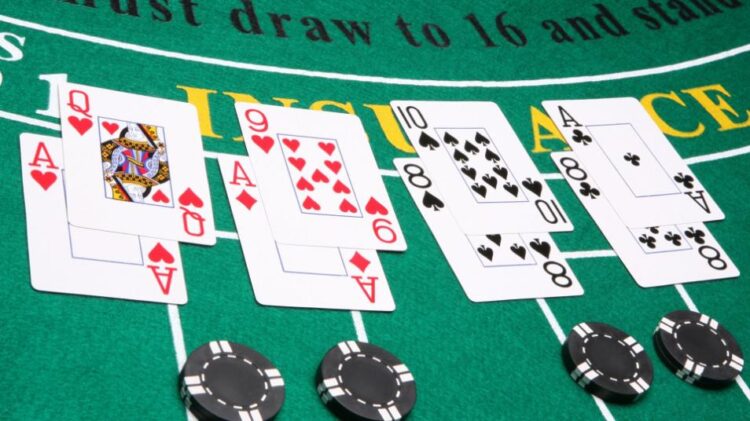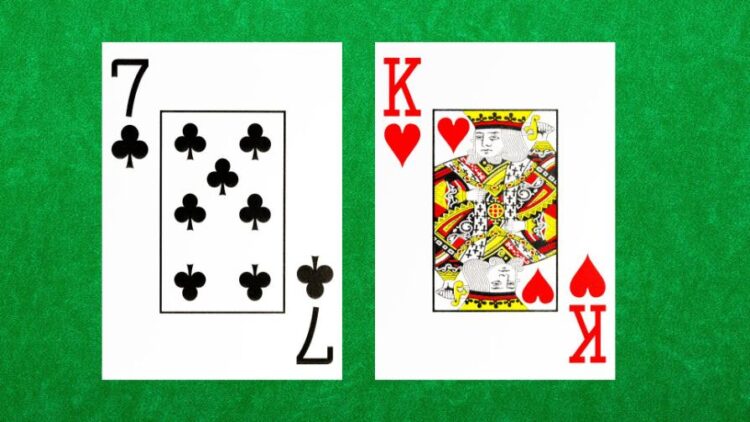
OBJECTIVE OF BLACKJACK: Beat the dealer by getting a count as close to 21 as possible, without going over 21.
NUMBER OF PLAYERS: 2 to 7 players
MATERIALS OF BLACKJACK: Between one and eight standard 52 card decks
TYPE OF GAME: Casino
AUDIENCE: Adult
OVERVIEW OF BLACKJACK

If you’ve ever been to a casino or watched a movie with a casino scene, no doubt you’ve heard of the famous casino game: Blackjack. Blackjack is one of the most popular casino games in the world, and while this game is super easy to play in theory, it involves both skill and luck. Blackjack is a game of strategy and statistics. And a good player will strive to consider all possibilities and choose moves that give the highest statistical chance for the greatest expected return.
In this article, we will teach you the basic Blackjack rules and how to play Blackjack, the classic casino game. We will show you basic strategy, explain the house edge, how to know when the dealer busts, side bets, insurance bets, Blackjack card values, and more. By the end, we will have you ready for when you sit at your first Blackjack table. How exciting!
OBJECTIVE OF BLACKJACK
Before we jump into the rules, first things first, what is the objective of Blackjack? You play this casino game against the dealer’s hand, and the objective? Get as close a score to 21 as possible without exceeding that number. In order to win when playing Blackjack, you must beat the dealer’s total. However, if you go over 21 points, that’s considered a bust and you automatically forfeit your bet.
SETUP FOR BLACKJACK
Blackjack is a much easier casino card game than poker. But, before we can begin playing this classic casino game, you’ll need to set it up. Let’s get to know the card values and how to deal so that we can get started!
Not sure what the difference between blackjack and poker is? Check out our guide pitting the two games against each other!
CARD VALUES
In blackjack, it’s absolutely essential that you know the card values.
- K, Q, J – 10 points
- 2 to 10 – Number listed on the card, meaning a 2 of clubs is worth 2 points.
- A – 1 or 11 points, depending on what the player wants.
Another important thing to note is that an ace and a 10 point card, such as a K, Q, J, or 10, is called a blackjack, the best hand in the game.

BETTING
Now that you know the card values, it’s time to place a bet! You must place a bet before the dealer deals any of the cards. Use poker chips just like a casino, real money, or random objects to make a bet. All players must place a bet before the dealer can deal the cards to start the game!
DEALING
The dealer plays an important role in Blackjack. The dealer deals to their left and deals themself last. Each player receives one face up card, but the dealer must deal themselves a face down card so that no one can know the value of that card. Then, the dealer deals another round of cards for each player, ensuring all of the cards (including the dealer’s) is face up. The first card must still remain face down.
INSURANCE BET
If the dealer’s face up card is an ace, then players may purchase an insurance bet, a side bet. Insurance odds pay out at 2 out of 1 and the maximum bet is half of the original wager.
The dealer then reveals the second card, and if he has blackjack, all players who purchased insurance are given their initial bet back.
For example, if you bet $10 initially, and the dealer’s face up card is an ace, you can get insurance for $5. If the dealer then has a blackjack, you win $10 from the insurance as well as your original $5 bet back. You lose your initial $10 bet unless you also have a blackjack.
However, if the dealer flips their face down card and they do not have a blackjack, you lose your $5 insurance bet money, and play continues as usual.
An insurance bet is not always a good idea. It’s bet to place this bet if you have a hand of 15 or more so that you still have a chance of winning if you lose the insurance bet.
EVEN MONEY
If a player has blackjack and the dealer’s face up card is an ace, that player can place a different kind of insurance bet, also called taking even money. Here, the player may win the amount of their original bet back, paid out at that moment, no matter what the dealer’s card is.
So, if a player’s original bet was $100, and they have a blackjack and the dealer has an ace, that player may withdraw themselves from the round by taking $200.
HOW TO PLAY BLACKJACK: BLACKJACK RULES

Now that the game is set up, it’s time to get into the official rules of Blackjack!
HITTING OR STANDING
If the dealer does not deal himself an ace as a face-up card, then they will ask the player on their left if they would like to “hit” or “stand.”
- Hit: Ask for another card. Gesture a hit by tapping the game table with your finger. Keep hitting until you want to stand. Just cross your fingers that you don’t bust, which means you’re out of that round! There is no limit on how many cards, so you can take as many as you want until you are satisfied.
- Stand: Pass. Gesture a stand by waving your hand over the table
Play continues in a clockwise direction until all players decide to either hit or stand.
So, how do you decide whether to hit or stand? It is totally up to you, but as a general rule, if your two cards are close enough to 21, especially compared to the dealer’s hand, you might be better off standing or staying. However, on the flip side, if your total is in the single digits, you might benefit from hitting and adding another card to your hand.
REVEALING THE DEALER’S SECOND CARD
Now that every player has had a chance to hit or stand, it’s time for the dealer to reveal their hidden second card! The dealer flips over their card. If the total is 16 or lower, the dealer must hit and take a third card. However, if the cards add up to 17 or more, the dealer must stand. All players that have a card total higher than the dealer wins!
Note that if the dealer has a blackjack, all players lose the round unless they also have a blackjack, which is called a push.
In the case of a push, or tie, the player gets their original bet back. So, that player does not win or lose.
PAYOUTS
Okay, so once everyone (including the dealer) has finished playing their hand, there are five potential outcomes:
- The dealer busts, in which case they pay even money to each hand still on the table. So, for example, if you bet $100, you would $100 and your money back, for a total of $200.
- The dealer makes a hand from 17 to 21, and you have the higher hand. Then, the dealer pays you one times your wager, so if you bet $100, you would win $100 and your money back, for a total of $200.
- The dealer makes a hand from 17 to 21, and the dealer has the higher hand. Then, the dealer sweeps your bet.
- You have a blackjack and beat the dealer. Then, the dealer pays you out at a 3:2 ratio, which means if you bet $100, you would win $150 and your money back, for a total of $250.
- As mentioned above, if you and the dealer have the same hand, this is a push, and the player gets their original bet back.
ADDITIONAL RULES OF BLACKJACK

Now that you know all the basic rules of Blackjack, it’s time to get into the additional rules of this fun casino game!
DOUBLING DOWN
After the first two cards are down, you can place an additional side bet that is equal to the original wager. When doubling down, you will receive just one more card for a total of three cards. Then, your hand is over, and you wait to see what the dealer has.
To double down, simply put up your bet equal to your original wager on the left side of your original bet. Then, the dealer will give you one more card and turn it sideways to signify you cannot take any more hits.
While doubling down only lets you hit once, you get an opportunity to earn much more money in a single round.
Although you generally put up an equal bet to your original wager, in some casinos, you may be able to double for less.
SPLIT
If your first two cards are the same value, you may put out a second wager and split your hand into two separate hands. In other words, a split hand equals two separate bets and the dealer will give each hand another hit. You must put the same number of chips down for the second split bet.
To reiterate, to split, your cards must be of the same value, so technically, you could split a hand that consists of a Queen and a 10, as they are both worth 10 points. But with that said, splitting a 20 is not generally considered a good strategy, so it’s up to you whether you want to risk it or not. As always, double-check the casino rules before playing, as the blackjack splitting rules may vary!
Splitting is like giving yourself another round and chance in Blackjack, as even if one hand busts, you still have one more hand that may beat the dealer!
To gesture that you want to split, separate your second and middle fingers into a peace sign. Then, the dealer will separate the two cards to create two separate hands and deal a second card on each.
Generally, you may not hit, double down, or split again after splitting your initial hand, but rules may differ depending on where you play.
In the case of splitting aces, rules again differ according to where you play. But usually, if you end up getting a 21 on one of your hands, this is not considered a blackjack, and you get a payout of just 1:1. But the 21-point hand will still push if the dealer gets a blackjack.
SURRENDERING
If you have a pretty bad hand and don’t think there’s any chance of winning your money back, one option is for you to surrender to the dealer instead of hitting or staying. When you surrender, you simply give up in exchange for half the original bet back, saving you from total loss.
To gesture and signal a surrender, slide your index finger across the game table horizontally. Just in case the dealer misses your full gesture, verbalize the word “surrender” as you gesture.
Keep in mind that not all casinos allow surrenders!
END OF GAME
After the end of a round, the dealer collects all the cards that were distributed and shuffles them again to start a new round.
Looking for other similar games to play? Check out Let It Ride Poker, Three Card Poker, and Baccarat!
CASINO ETIQUETTE AND RULES WHEN PLAYING BLACKJACK
Here are some of the casino etiquette tips to keep in mind:
- Always follow casino rules.
- Put your money on the table instead of handing it to the dealer.
- Do not touch your cards.
- Always use hand signals to call your plays.
- Do not stay on your phone, but if you have a reference chart in your home, confirm with the dealer first.
- Tip the dealer.
UNDERSTANDING THE ODDS IN BLACKJACK
The probability of you winning a game of Blackjack is 42.22%, while the probability of the dealer winning is 49.1%. The remaining 8.48% is the probability of a push or tie.
The probability of busting depends on what cards you have. Understanding the probability of a bust can come in handy when you decide whether to hit or stand after the first two cards are dealt.
| Your Hand Value | Probability of Busting |
|---|---|
| 11 or lower | 0% |
| 12 | 31% |
| 13 | 39% |
| 14 | 56% |
| 15 | 58% |
| 16 | 62% |
| 17 | 69% |
| 18 | 77% |
| 19 | 85% |
| 20 | 92% |
| 21 | 100% |
BLACKJACK STRATEGY

Now that you know the blackjack rules, it’s time to get to know the strategy so you can win! What are some of the most common strategies to keep in mind when playing Blackjack?
STAY WHEN YOUR HAND IS 17 OR HIGHER
The odds aren’t really in your favor of receiving an ace, 2, 3, or 4 when you hit. So, if you have a decent hand already, it’s often safer to stay and hope your hand isn’t lower than the dealer’s!
SPLIT 8S AND ACES
If you have a pair of 8s or aces, it’s better to split. This is because if you have two aces, this could lead to more winnings or at least a more chance of winning. And if you have two 8s, you might be able to cut your losses rather than playing one hand of 16 and hitting.
DOUBLE DOWN ON A HARD 10 OR 11
If you have a hard 10 or 11, double down to win more money. A hard 10 or 11 means you have two cards that add up to 10 or 11 and don’t include an ace. You have a higher chance of winning more money when you double down in this instance.
DON’T BET ON INSURANCE
More often than not, an insurance bet is not the best way to make money. If the dealer has an ace, the chances of whether the dealer will have a 10 face down card are hard to tell. So, it’s better to be safe than sorry and simply continue to play.
HOW TO COUNT CARDS IN BLACKJACK
Before we get into the nitty-gritty of counting cards in Blackjack, keep in mind that while counting cards is not technically against the rules, most casinos don’t like the practice. So, unless the locale you are attending is specifically okay with counting cards, it’s best to avoid doing it as much as you can. With that said, it’s really hard for anyone to police your brain!
To count cards in Blackjack, with the Hi-Lo counting system, assign each card a value:
- 2-6: +1
- 7-9: 0
- 10-A: -1
Then, keep a running count of the round by adding and/or subtracting each card by their value. Yes, that means you count not only your cards but also every player’s and the dealer’s cards in order to calculate the running count. The higher the running count, the more of an advantage you have. But if the running count goes negative, the casino has an advantage.
So, for example, if you have a J and 10, the player to your right has a 3 and 7, and the dealer has 6, the running count would be 0.
Generally, casinos will use multiple decks in order to deter card counters, so to counteract this, the next step is to get the true count by dividing the running count by the decks.
For example, if the running count is +5 and there are 6 decks left, the true count is 0.83. But if the running count is +5 and there is just one deck remaining, the true count is 5.
FAQ
If You Beat the Dealer But Not The Other Players, Do You Win?
Unlike poker, the other players’ hands at the table have nothing to do with you winning or losing. To win, you must simply beat the dealer.
Is Blackjack Skill or Luck?
If you are a beginner, Blackjack is likely a luck game for you. But as you develop skills, the game is a blend of both skill and luck.
What Are Your Chances of Winning in Blackjack?
The chances of winning in Blackjack is 42.44%, and the chances of a dealer winning is 49.1%. There is a further 8.48% chance of a tie. Furthermore, the chance of getting a 21 in Blackjack is a mere 4.75%.
What Is the Best Hand in Blackjack?
The best hand in Blackjack is, of course, blackjack. That is an ace with a king, queen, jack, or ten.
Is Counting Cards Allowed in Blackjack?
Yes, you can count cards in Blackjack! Contrary to popular belief, counting cards in Blackjack is not illegal or against the rules. It is simply casinos that don’t like the practice.
Related Articles
- 30 Awesome Dinner Party Games - January 6, 2025
- 35 BIRTHDAY PARTY GAMES FOR ADULTS - December 10, 2024
- 30 Top New Year’s Eve Party Games - December 3, 2024